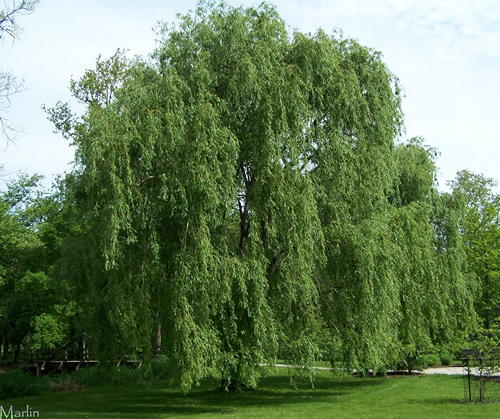 |
White Willow – Salix alba Family Salicaceae -Willow, Cottonwood, Aspen. This fast-growing but short-lived tree's name refers to its leaflets' white undersides. |
Custom Search
|
Black Willow Catkin – Salix nigra. Willows are insect-pollinated (entomophilic) |
| White willow, like all willows, is a fast-growing but short-lived tree. Its wood is strong and lightweight but very brittle, hence its reputation as a "dirty" tree; if present in a home landscape, the windthrown branches present a constant litter problem. |
Early spring white willow specimen, grown from a cutting, is 28 years old
|
Willows are generally found near watercourses or standing water. They are thirsty trees indeed, and the roots will grow up to three times the crown diameter in search of underground water sources (where they just might invade your well, sewer line or septic field).
|
Willow bark has been known as an analgesic (pain killer) and antipyretic (fever-reducer) since ancient times, being mentioned in ancient texts of the Egyptians, Sumerians and Assyrians [3]. Willow bark was steeped as tea by Native Americans, and the young twigs and bark chewed to relieve headaches. It has since been shown the active ingredient is salicylic acid, the basis of today’s aspirin. "Salicylic" derives from the willow genus Salix, as does the family name Salicaceae [2].
|
| References: 1. Wikipedia, "Saxis fragilis" 2. NATIONAL AUDUBON SOCIETY, National Audubon Society Field Guide to North American Trees 3. Wikipedia, Salix alba |
| Tree Encyclopedia / North American Insects & Spiders is dedicated to providing scientific and educational resources for our users through use of large images and macro photographs of flora and fauna. |
 |
Family Salicaceae — Willow, Cottonwood, Aspen There are only two genera in this family, Salix (willows), with about 300 species, and Populus (poplars), with barely 40 species. Salicaceae are found throughout the temperate parts of the world, with the majority of species occurring in the north; both willows and poplars have a strong affinity for water. Tree Encyclopedia | Tree Index | Walnuts, Hickories, Butternut, Pecan |

